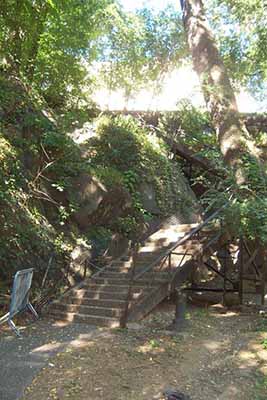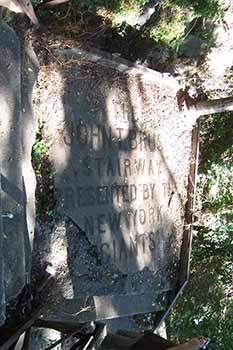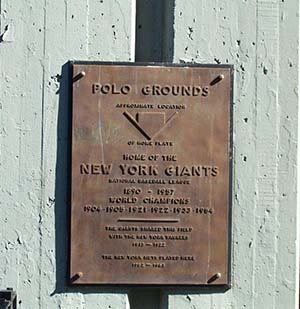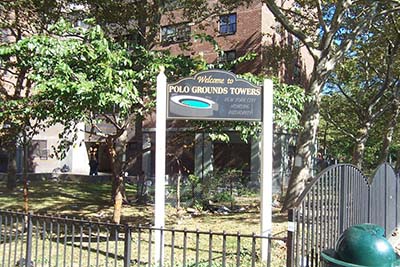Past Ballparks of New York City
New
York City (Manhattan, Queens & Brooklyn)
September 29, 2007
By
Ken Schlapp
When I took my big trip in 2003, I made every effort to visit all
the sites of old baseball stadiums that I knew about and were
accessible. The one big exception to that plan was New York City,
the place where most organized and professional base ball (I used
two words on purpose, because that is how baseball was known in the
beginning) got its start and more importantly, the place I lived!
Therefore, four years after the big trip, I joined my Friend David
Dyte for an all-encompassing New York baseball journey around the
city to visit historic base ball sites. David (along with Andrew
Ross), maintains a website called
Brooklynballparks.com and
is one of Brooklyn’s biggest fans and promoters, despite the fact
that he is an Australian native.
 This
site has everything on just about every past and present ball field
in Brooklyn and its outskirts and is a great read. 3 times prior
this journey, David had trekked through the city to visit all of the
Brooklyn sites, by public transportation. However, this time, we
were going to go by car and include all the sites in Manhattan as
well. This
site has everything on just about every past and present ball field
in Brooklyn and its outskirts and is a great read. 3 times prior
this journey, David had trekked through the city to visit all of the
Brooklyn sites, by public transportation. However, this time, we
were going to go by car and include all the sites in Manhattan as
well.
David is also a huge Brooklyn (and Los Angeles) Dodger fan, so I had
to make him visit the sites of his hated New York Giants. One of my
uncles, and my older cousins were New York Giants fans, so for me
when I was very young, I thought the Mets and Giants were the only
two teams, and when my brother Steve would annoy me, I would say I
am going to root for the Giants instead of the Mets. I eventually
learned that was not the case, but my old New York baseball affinity
lies with the Giants. In fact, much to David’s chagrin, I wore a
Giants shirt for our journey.
We got started early on a Saturday morning right in front of my
apartment. David took the subway to meet me there on 94th
street between 1st and 2nd Avenues, which just
happens to be the street that Lou Gehrig grew up on. Therefore, all
we had to do was walk down the block to see the plaque that was
dedicated by the Yankees in 1990 to both Lou Gehrig and the youth of
Yorkville, which was the home of both Lou Gehrig and me. This is a
cool coincidence. From there we hopped in my car and continued
through Manhattan.
Our first stop was between 110th and 112th
Streets and 5th and 6th Avenues, which is at
the edge of Central Park, but from 1876 through 1889 was the home of
the original Polo Grounds. The Polo Grounds was built for playing
Polo, but quickly added professional baseball to the mix.
 The
New York Metropolitans of the American Association played there from
1880 to 1882, and the New York Gothams (later known as the Giants)
played there from 1882 to 1889. In fact, at one point, they divided
the grounds into an Eastern and a Western diamond so both teams
could play simultaneously, but this did not work, and they ended up
using only the Eastern diamond. In 1889, the city built a street
through the grounds on 111th street, which forced the
Giants to find a new home. Today, you can see buildings on the spot
the Polo Grounds once stood, with a church, apartments and other
typical city dwellings, with no mention or memories of the former
home of the Giants. The
New York Metropolitans of the American Association played there from
1880 to 1882, and the New York Gothams (later known as the Giants)
played there from 1882 to 1889. In fact, at one point, they divided
the grounds into an Eastern and a Western diamond so both teams
could play simultaneously, but this did not work, and they ended up
using only the Eastern diamond. In 1889, the city built a street
through the grounds on 111th street, which forced the
Giants to find a new home. Today, you can see buildings on the spot
the Polo Grounds once stood, with a church, apartments and other
typical city dwellings, with no mention or memories of the former
home of the Giants.
In 1890, the Giants were forced to move further uptown to 155th
Street and 9th Avenue, so David and I did the same
thing. We went right for the John T Brush Stairway, which is the
last remnant of the last (4th) version of the Polo
Grounds. This stairway led up to one of the Stadium’s ticket
booths, which was high up above the stadium on Coogan’s Bluff. At
one time, the
 Playing
field could be seen from there. We parked nearby once we found it,
which was not all that easy to find. When we got there, we could
see that it was not in good shape at all. We decided to walk up the
stairway (without realizing that there were signs saying not to do
so) and realized how bad of shape it was in, and that it probably
was not the safest thing for us to do. However, it did allow us to
get a great view of the crumbling stone concrete dedication plaque,
which was presented by the New York Giants. As much as it was in
disrepair, it is still great that a part of the Polo Grounds still
exists. The other thing I learned as we climbed to the top of the
stairs and around the top of a hill to the street above was that
David was afraid of heights and not so happy with my choice to go
up. Playing
field could be seen from there. We parked nearby once we found it,
which was not all that easy to find. When we got there, we could
see that it was not in good shape at all. We decided to walk up the
stairway (without realizing that there were signs saying not to do
so) and realized how bad of shape it was in, and that it probably
was not the safest thing for us to do. However, it did allow us to
get a great view of the crumbling stone concrete dedication plaque,
which was presented by the New York Giants. As much as it was in
disrepair, it is still great that a part of the Polo Grounds still
exists. The other thing I learned as we climbed to the top of the
stairs and around the top of a hill to the street above was that
David was afraid of heights and not so happy with my choice to go
up.
Above that stairway and to the left is now Coogan’s Bluff Park.
This is the spot that fans would come to look into Coogan’s Hollow,
where they could watch baseball games from high above without having
to buy a ticket. Now Coogan’s bluff overlooks the Polo Grounds
Towers, which are housing projects.
 We
walked over to the rocks where many a baseball game was watched and
definitely got that nostalgic feeling. There were 2 holes in one of
the huge rocks on the Bluffs that may have held a flag or some kind
of signs or structures to the old Polo Grounds, but I do not know
for sure. From there we headed down a long staircase aside the
yellow car bridge to descend from Coogan’s Bluff down to Coogan’s
Hollow. However, the first thing we noticed as we were about to
descend was Yankee Stadium in the near distance across the Harlem
River. It is amazing how close The Polo Grounds and Yankee Stadium
were to each other. They were less than a mile apart, but separated
by water. In fact, if you come across some old aerial photos you
can see it for yourself. We
walked over to the rocks where many a baseball game was watched and
definitely got that nostalgic feeling. There were 2 holes in one of
the huge rocks on the Bluffs that may have held a flag or some kind
of signs or structures to the old Polo Grounds, but I do not know
for sure. From there we headed down a long staircase aside the
yellow car bridge to descend from Coogan’s Bluff down to Coogan’s
Hollow. However, the first thing we noticed as we were about to
descend was Yankee Stadium in the near distance across the Harlem
River. It is amazing how close The Polo Grounds and Yankee Stadium
were to each other. They were less than a mile apart, but separated
by water. In fact, if you come across some old aerial photos you
can see it for yourself.
Once down below, you immediately find signs indicating that you were
in front of Polo Grounds Towers, and can easily find the plaque
stating: “This development was built on the location that Willie
Mays and the
 Giants
made famous”. There is another plaque on the grounds that signify
the approximate location that home plate once stood. It also lists
that this was the home of the Giants from 1890 to 1957, the Yankees
from 1912 to 1922, and the Mets from 1962 to 1963. It also
celebrates the six championships that the Giants won while playing
there. The amusing thing for us is that we had a hard time finding
the plaque, but it was obvious to the locals that we were looking
for something and did not look like the typical tenant, so a few
very nice people helped guide us to where it is. Giants
made famous”. There is another plaque on the grounds that signify
the approximate location that home plate once stood. It also lists
that this was the home of the Giants from 1890 to 1957, the Yankees
from 1912 to 1922, and the Mets from 1962 to 1963. It also
celebrates the six championships that the Giants won while playing
there. The amusing thing for us is that we had a hard time finding
the plaque, but it was obvious to the locals that we were looking
for something and did not look like the typical tenant, so a few
very nice people helped guide us to where it is.
However, the plaque, fails to mention that the football Giants
played there from 1925 to 1955 and the AFL’s New York Titans (Jets),
played there from 1960 to 1963. It also, missed the fact that the
New York Giants of the Players League was actually the first Tenant
of Polo Grounds III in 1890, while the New York Giants of the
National League played next door at Polo Grounds II. Although, in
1890, Polo Grounds III was known as Brotherhood Park and was not
known as the Polo Grounds
 until
the NL Giants moved in for the 1891 season when the Players League
folded. For that one season when both teams played in Coogan’s
Hollow, a fan in the upper deck could at times see both games at
once! Polo Grounds II later became known as Manhattan Field, but
was gone long before the final Polo Grounds was demolished in 1964.
Polo Grounds III was burnt down in a fire in 1911, but rebuilt again
as Polo Grounds IV (known that way historically, but not likely in
the vernacular sense) in the same year. until
the NL Giants moved in for the 1891 season when the Players League
folded. For that one season when both teams played in Coogan’s
Hollow, a fan in the upper deck could at times see both games at
once! Polo Grounds II later became known as Manhattan Field, but
was gone long before the final Polo Grounds was demolished in 1964.
Polo Grounds III was burnt down in a fire in 1911, but rebuilt again
as Polo Grounds IV (known that way historically, but not likely in
the vernacular sense) in the same year.
Lastly, before heading west to Hilltop Park we saw a beautifully
painted mural painted on the wall of the playground across the
street from the towers. We had a great trip through the Giants
Manhattan history, but now it was time to delve into the past of a
team we both despise…The Yankees.
NYC Ballparks Part II |